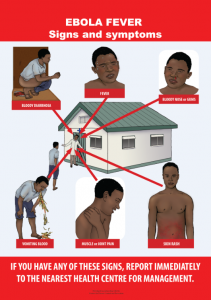The Centers for Disease Control and Prevention (CDC) published Friday a document that reviews the hot topic of human-to-human transmission of Ebolavirus. A good section on the issue of airborne transmission is included in the text and here is a portion:

Airborne transmission of Ebola virus has been hypothesized but not demonstrated in humans. While Ebola virus can be spread through airborne particles under experimental conditions in animals, this type of spread has not been documented during human EVD outbreaks in settings such as hospitals or households. In the laboratory setting, non-human primates with their heads placed in closed hoods have been exposed to and infected by nebulized aerosols of Ebola virus. In a different experiment, control monkeys were placed in cages 3 meters away from the cages of monkeys that were intramuscularly inoculated with Ebola virus. Control and inoculated monkeys both developed Ebola virus infection.The authors concluded that “fomite and contact droplet” transmission to the control monkeys was unlikely, and that airborne transmission was most likely, but they did not discuss the potential behaviors of caged non-human primates (e.g., spitting and throwing feces) that might have led to body fluid exposures.
Related: The chance of Ebola going airborne is so remote, let’s not frighten people: Virologist
Similarly, an outbreak of Reston virus (Reston ebolavirus species, which does not cause EVD in humans) infection occurred in a quarantine facility housing non-human primates in separate cages and the transmission route could not be confirmed for all infected primates. Multiple animal handlers developed antibody responses to Reston virus suggesting asymptomatic infection was occurring in humans with direct animal contact and implicating animal handling practices in transmission between primates. In a different study, piglets that were oronasally inoculated with Ebola virus were able to transmit infection to caged non-human primates that were placed 20 cm from the piglets. The piglet and primate cubicle design did not permit the investigators to distinguish among aerosol, small or large droplet, or fomite transmission routes, and it was noted that pigs are capable of generating infectious short range aerosol droplets more efficiently than other species. A more recent experiment that was specifically designed to further evaluate the possibility of naturally-occurring airborne transmission of Ebola virus among non-human primates showed no transmission of Ebola virus from infected to control primates placed 0.3 meters apart in separate open-barred cages and ambient air conditions, but with a plexiglass divider that prevented direct contact between the animals.
Related: A look at Ebola transmission
Click the link HERE for the whole CDC document


It being extremely difficult to prove in real life conditions in no way precludes the facts that medical staff are dying from Ebola, and that good practices dictate going to a higher level of protection.